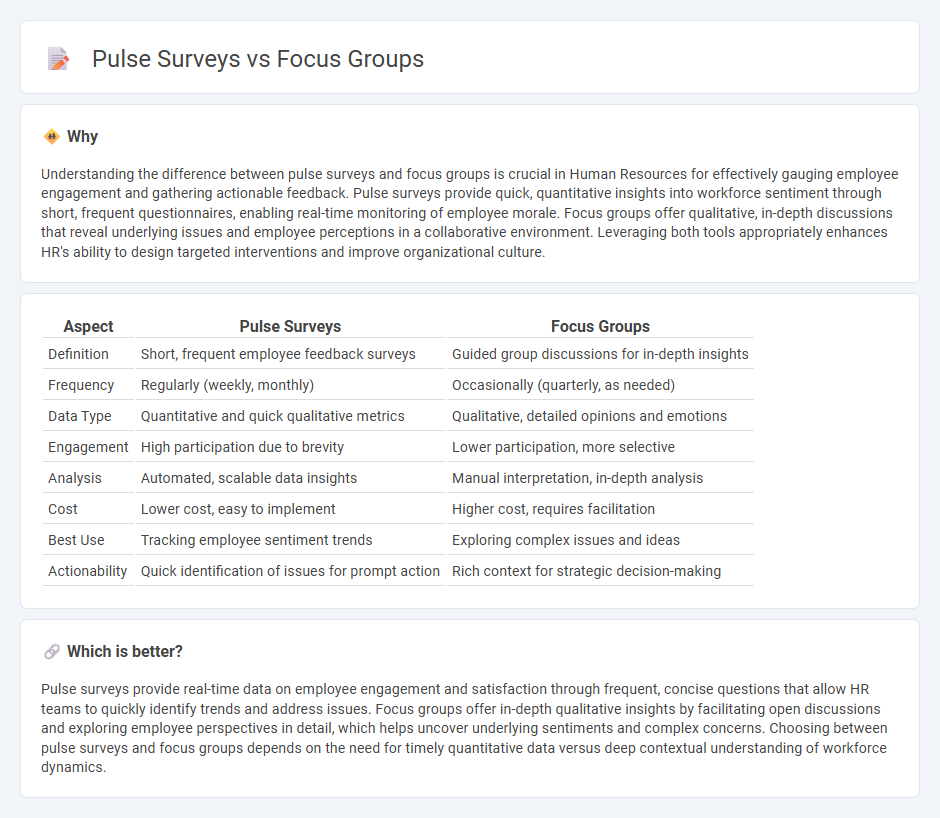
Pulse surveys provide quick, real-time employee feedback through concise questionnaires, enabling organizations to monitor engagement and sentiment regularly. Focus groups offer in-depth insights by facilitating interactive discussions, uncovering nuanced opinions and underlying issues within teams. Explore our detailed comparison to understand which method best fits your human resources strategy.
Why it is important
Understanding the difference between pulse surveys and focus groups is crucial in Human Resources for effectively gauging employee engagement and gathering actionable feedback. Pulse surveys provide quick, quantitative insights into workforce sentiment through short, frequent questionnaires, enabling real-time monitoring of employee morale. Focus groups offer qualitative, in-depth discussions that reveal underlying issues and employee perceptions in a collaborative environment. Leveraging both tools appropriately enhances HR's ability to design targeted interventions and improve organizational culture.
Comparison Table
| Aspect | Pulse Surveys | Focus Groups |
|---|---|---|
| Definition | Short, frequent employee feedback surveys | Guided group discussions for in-depth insights |
| Frequency | Regularly (weekly, monthly) | Occasionally (quarterly, as needed) |
| Data Type | Quantitative and quick qualitative metrics | Qualitative, detailed opinions and emotions |
| Engagement | High participation due to brevity | Lower participation, more selective |
| Analysis | Automated, scalable data insights | Manual interpretation, in-depth analysis |
| Cost | Lower cost, easy to implement | Higher cost, requires facilitation |
| Best Use | Tracking employee sentiment trends | Exploring complex issues and ideas |
| Actionability | Quick identification of issues for prompt action | Rich context for strategic decision-making |
Which is better?
Pulse surveys provide real-time data on employee engagement and satisfaction through frequent, concise questions that allow HR teams to quickly identify trends and address issues. Focus groups offer in-depth qualitative insights by facilitating open discussions and exploring employee perspectives in detail, which helps uncover underlying sentiments and complex concerns. Choosing between pulse surveys and focus groups depends on the need for timely quantitative data versus deep contextual understanding of workforce dynamics.
Connection
Pulse surveys and focus groups are connected as complementary tools in Human Resources for gathering employee feedback and insights. Pulse surveys provide quick, quantitative data on employee engagement and satisfaction, while focus groups offer qualitative, in-depth discussions that explore underlying issues and ideas. Together, they enable HR teams to identify trends, address concerns, and implement targeted strategies for workforce improvement.
Key Terms
Qualitative feedback (Focus Groups)
Focus groups provide in-depth qualitative feedback by facilitating open discussions that explore participants' attitudes, opinions, and emotions toward a product or service. Unlike pulse surveys that gather quick, quantitative snapshots, focus groups enable deeper insights into complex issues through interactive dialogue and observation. Discover more about how focus groups can enhance your customer understanding and decision-making process.
Quantitative data (Pulse Surveys)
Pulse surveys deliver rapid, quantitative insights by collecting large-scale employee feedback on specific metrics such as engagement, satisfaction, or productivity. These short, frequent surveys enable data-driven decisions through real-time trend analysis and statistical benchmarking across departments or organizations. Explore how pulse surveys can transform your workforce analytics with precise, actionable quantitative data.
Employee engagement
Focus groups provide in-depth qualitative insights into employee engagement by facilitating open discussions and capturing nuanced feedback, while pulse surveys offer quick, quantitative data through frequent, short questionnaires that track engagement trends over time. Combining both methods delivers a comprehensive understanding of employee sentiment, enabling targeted interventions to boost morale and productivity. Explore more to optimize your employee engagement strategy effectively.
Source and External Links
What Is a Focus Group? Definition and Guide - A focus group involves 6-10 people discussing a product or service to provide deep insights into consumer attitudes and behaviors.
Focus Groups - Focus groups gather individuals with a common characteristic to discuss their experiences and perspectives on specific topics, often used to supplement other research methods.
Focus Group - A focus group is a qualitative research method involving a small group of demographically diverse participants discussing their reactions to specific ideas or products.
 dowidth.com
dowidth.com